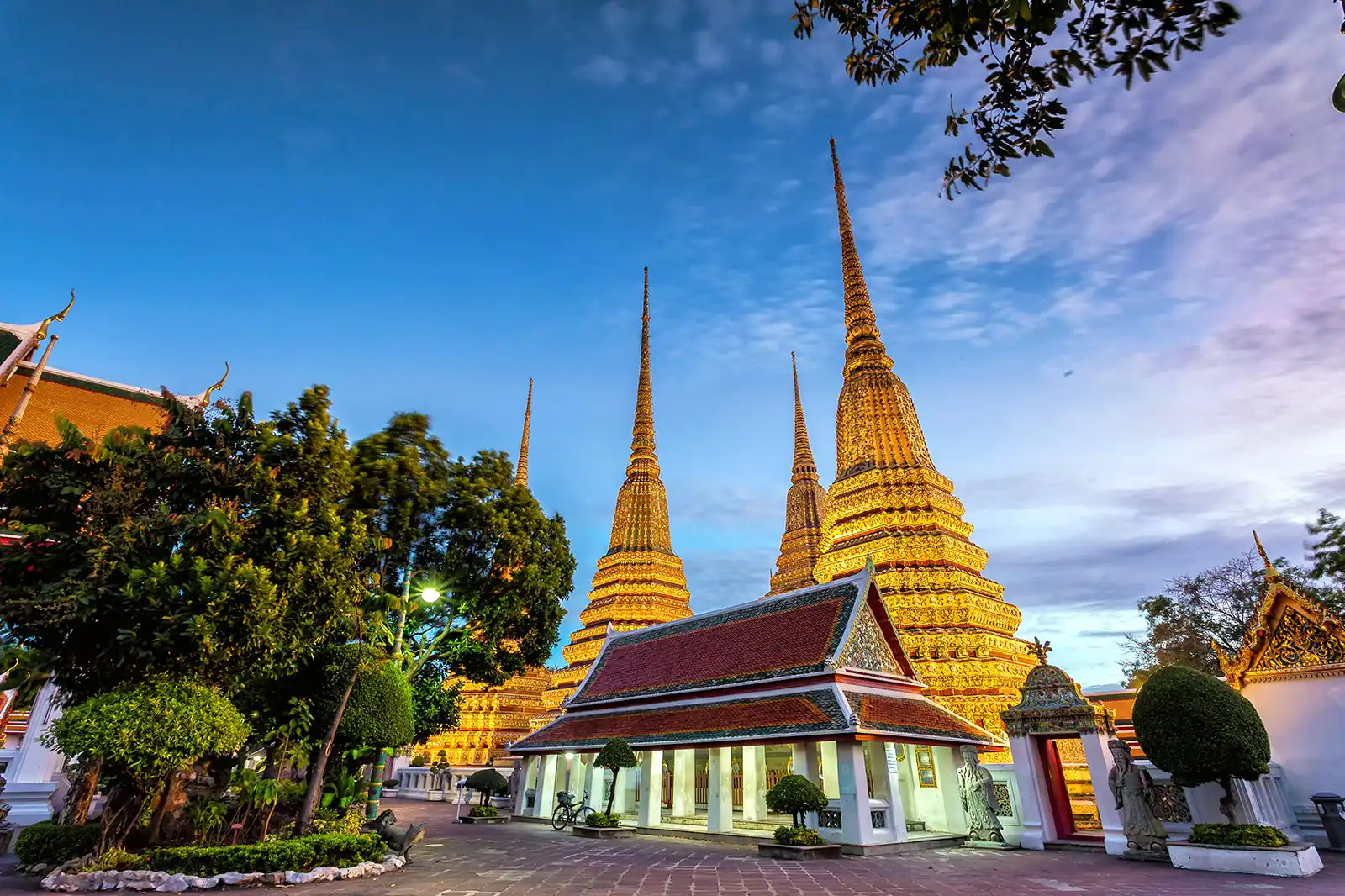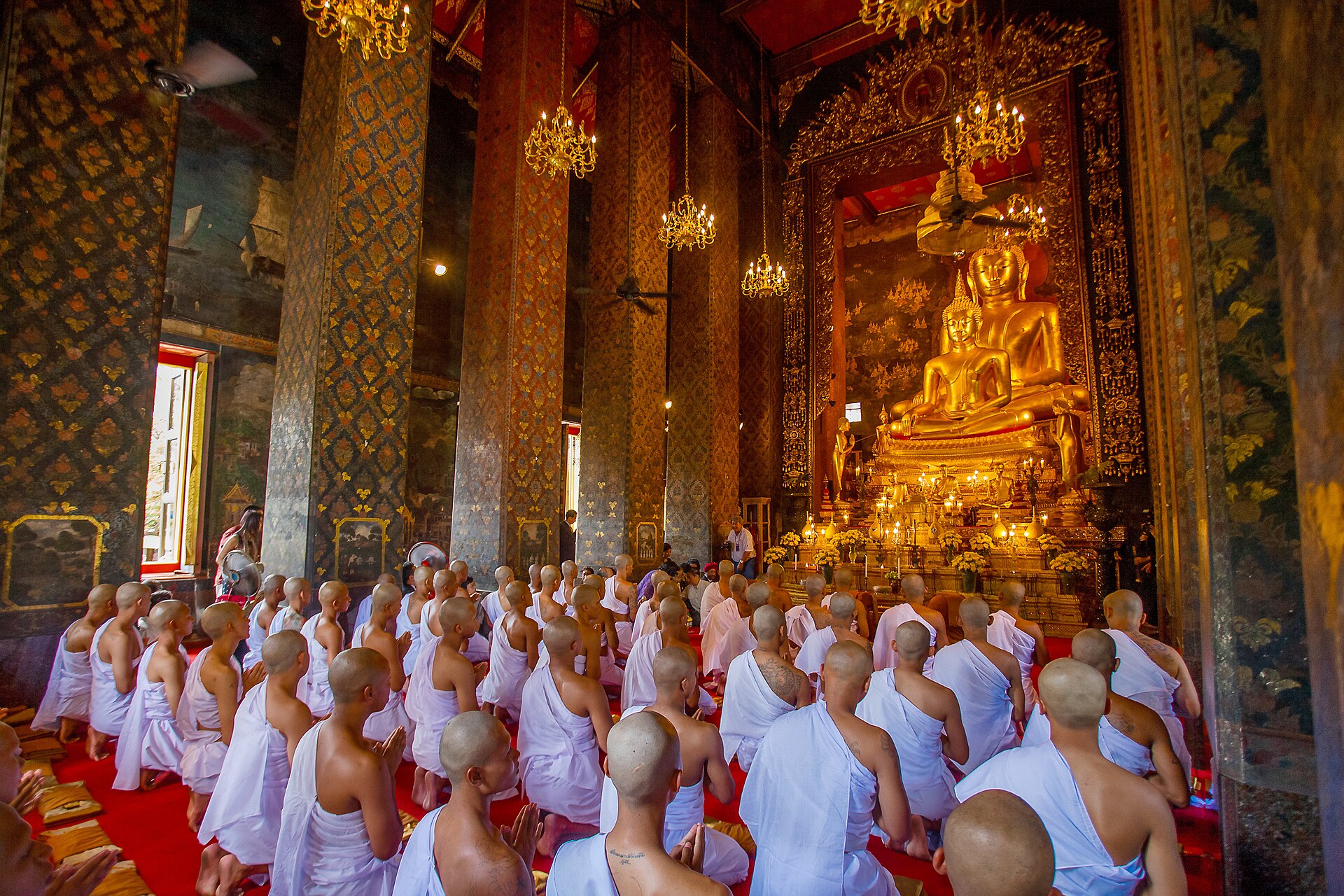Are you embarking on a journey through Bangkok’s historic landmarks with Mihitravel? Ensure Wat Pho, the famed Temple of the Reclining Buddha, is on your itinerary. As one of the city’s most illustrious temples, Wat Pho offers a unique blend of spiritual serenity and architectural grandeur. Dive into an experience that seamlessly intertwines Thailand’s ancient traditions with its vibrant present. Let’s delve deeper into the captivating allure of Wat Pho and see why it’s a must-visit for every traveler to Bangkok.
Best time to visit Thailand – All of the things you may need
Wat Pho
Location: Maharat Road, Phra Nakhon, Bangkok 10200, Thailand
Open: Daily from 8.30 am to 6.30 pm (massage available until 6 pm)
Phone: +66 (0)2 226 0335
Step into the mesmerizing realm of Wat Pho, Bangkok’s iconic sanctuary, where the majestic Reclining Buddha awaits. Nestled just a stone’s throw away from the Temple of the Emerald Buddha, this vast temple complex boasts a colossal 46-meter-long golden Buddha, shimmering in all its glory.
Are you journeying from the Grand Palace? A leisurely 10-minute stroll will lead you to this haven. While the Reclining Buddha is undeniably the star attraction, the temple’s expansive grounds offer a tranquil escape from the city’s hustle. Many visitors are so captivated by the Buddha that they overlook the serene corners of the temple, gifting you a peaceful exploration.

And for those seeking rejuvenation, Wat Pho isn’t just a visual treat. It’s renowned as Thailand’s premier massage school. Indulge in an authentic Thai massage here, and let skilled hands transport you to relaxation.
History of Wat Pho
Nestled in the heart of Bangkok, Wat Pho, officially known as Wat Phra Chetuphon Wimon Mangkhalaram Rajwaramahawihana, stands as a testament to Thailand’s rich history. Its origins trace back to the 16th century, during the late Ayuthaya era when it was initially erected as Wat Phodharam. However, its significant transformation began in 1788 under the reign of King Rama I, who had just established Bangkok as the nation’s capital and constructed the adjacent Grand Palace.
The temple’s expansive growth and architectural marvels, especially the South Vihara and the West Vihara housing the magnificent Reclining Buddha, were majorly attributed to King Rama III’s vision in 1832. This Reclining Buddha, completed in 1848, is crafted from plaster around a brick core, adorned with gold leaf, and stands as Bangkok’s largest.
But Wat Pho is not just an architectural wonder; it’s an educational hub. King Rama III envisioned it as Bangkok’s inaugural public university. The temple grounds are adorned with over a thousand Buddha depictions, sculptures, and artworks, all commissioned to enlighten visitors about history, literature, and Buddhism.
A significant contribution of King Rama III was the addition of 1431 stone inscriptions between 1831 and 1841. These inscriptions, crafted by Thai scholars, aimed to preserve the nation’s cultural heritage, including the art of Thai massages. This initiative solidified Wat Pho’s reputation as the epicenter for traditional Thai medicine teachings. The temple underwent its latest restoration in 1982 in preparation for Bangkok’s Bicentennial Celebration, ensuring its legacy for generations.
The Temple of the Reclining Buddha
The Reclining Buddha at Wat Pho
The Reclining Buddha at Wat Pho is undeniably the centerpiece of attraction for visitors. This colossal statue, standing at 15 meters in height and stretching 46 meters in length, seems too grand for its enclosure. A closer look at the Buddha’s feet reveals a detailed 5-meter canvas adorned with intricate mother-of-pearl depictions, symbolizing the auspicious laksas or characteristics that guided Buddha towards enlightenment. 108 is significant, representing the positive actions and symbols that steered Buddha to perfection.
Before entering this sacred space, visitors are required to remove their shoes. For those seeking a touch of fortune, there’s an opportunity to buy a bowl of coins at the hall’s entrance. These coins can be dropped into the 108 bronze bowls lining the aisle, producing a musical chime. While it’s a gesture of good luck, the collected funds are channeled towards the temple’s preservation and renovation by the monks. Given the sanctity of the place, visitors are reminded to dress respectfully, ensuring shoulders are covered, and attire extends below the knees.
Phra Ubosot
Constructed during the era of Rama I, with architectural inspirations from the Ayuthaya style, the bòht (ordination hall) has undergone significant transformations, particularly during the time of Rama III. Visitors are greeted within its walls by captivating murals and the majestic three-tiered pedestal holding the Phra Buddha Deva Patimakorn. This statue is considered the second most significant Buddha image within the compound. A poignant touch to the hall is the interment of Rama I’s ashes, further elevating its historical and spiritual significance.
Other Buddha statues
The four wí·hăhn encircling Phra Ubosot house a collection of remarkable images that captivate visitors. Of particular note are the Phra Chinnarat and Phra Chinnasri Buddhas, located in the western and southern chapels. These exquisite pieces were salvaged from Sukhothai by kin of Rama I. Connecting these four structures are galleries showcasing a staggering 394 gilded Buddha statues. These representations encompass many Thai artistic styles, from the classic Lopburi to the contemporary Ko Ratanakosin.
Ancient inscriptions
Surrounding Phra Ubosot stands a modest marble barrier adorned with 152 bas-reliefs that illustrate tales from the Ramakian, Thailand’s rendition of the Ramayana. As you leave the temple, you might spot familiar images among street vendors’ wares. These popular rubbings are crafted from cement molds inspired by Wat Pho’s original reliefs.

A stone’s throw away, to the west of Phra Ubosot, lies a pavilion that houses inscriptions recognized by UNESCO. These inscriptions illuminate the principles of traditional Thai massage. Along with around 2,000 other stone tablets encompassing diverse facets of Thai wisdom, they cement Wat Pho’s reputation as Thailand’s inaugural public learning institution.
Royal Chedi
The west end of Wat Pho houses a remarkable quartet of grand chedi, each dedicated to the initial four monarchs of the Chakri dynasty. These chedi, adorned with tiles, showcase the distinctive Ratanakosin style with their unique square bell shape and sharp corners. Their hues mirror the colors of the Buddhist flag. The central chedi, a tribute to Rama I, enshrines the majestic Phra Si Sanphet Dayarn, a towering 16-meter Buddha statue from Ayuthaya. The temple grounds are also dotted with 91 smaller chedi, some of which hold the ashes of the royal family’s lesser-known members.
Phra Mondop
The Phra Mondop, an elevated structure referred to as hǒr đrai, is a sanctuary for sacred Buddhist scriptures. Four yaksha, mythical guardian demons, zealously protect this significant edifice. According to local lore, a dispute among these guardians resulted in forming the area now recognized as Tha Tien. A stone’s throw away to the south of Phra Mondop lies the Crocodile Pond, which, interestingly, is devoid of any crocodiles today.
Sala Kan Parian
The Sala Kan Parian stands in the compound’s southwest corner, a testament to Wat Pho’s rich history. This tower, constructed in the distinctive Ayuthaya architectural style, is among the few remnants predating the expansive renovations undertaken by Rama III in the 19th century. Historically, this structure served as the main bòht of the temple, housing its principal Buddha statue.
Granite statues
Wat Pho is not just a sanctuary for monks and visitors; it also hosts a unique assembly of stone figures. Originally used as ballast on Chinese ships, these granite giants now stand guard at temple entrances and courtyards. These statues, rich in detail, showcase various Chinese personas. Among them are the Lan Than, depicted as noblemen warriors with intense eyes and adorned in Chinese opera attire. There’s also a figure donning a straw hat, representing a farmer caught amidst his daily chores. And suppose you spot a statue with a hat resembling a fedora, sporting a neat beard and mustache. In that case, that’s none other than Marco Polo, credited for introducing European fashion to the Chinese elite.
The grounds
The grounds of Wat Pho are adorned with quaint Chinese-inspired rock gardens and miniature hill islands, offering a refreshing contrast to the temple’s expansive tiled courtyards. These gardens provide shade and a touch of green and feature whimsical decorations that capture the essence of daily life. A standout among these is a unique rockery adorned with figures of the hermit Khao Mor, believed to be the pioneer of yoga, showcasing various therapeutic poses. Another significant landmark within the temple is a Bodhi tree directly south of the main wí·hăhn. This tree, grown from a cutting of the original tree under which Buddha is believed to have achieved enlightenment, gives the temple its informal name, Wat Pho.
Order Highlights
Exploring the vast expanse of Wat Pho is a treat for the senses. While you can opt for knowledgeable English-speaking guides available for a fee, ranging between 200 to 400 baht based on your group size and bargaining prowess, the temple also welcomes those who wish to meander on their own.
A must-visit within the temple complex includes the four chapels, home to an impressive collection of 394 gilded Buddha statues. These golden figures, representing various regions of Thailand, are all seated gracefully in the meditative lotus position. The temple’s walkways are adorned with intricate murals, so detailed that even without understanding their full significance, one can’t help but be captivated by their artistry.
Additionally, scattered throughout Wat Pho’s courtyards are quirky Chinese statues, which historically served as ship ballasts, and 91 beautifully decorated chedis (stupas) adorned with ceramic pottery and vibrant tiles. The temple is a spiritual haven and an artistic masterpiece waiting to be explored.
Tickets and Other Practicalities
Wat Pho Dress Code
When visiting Wat Pho, it’s essential to dress respectfully. Opt for long skirts or trousers and shirts with sleeves. Before entering the temple, you’ll need to remove your shoes. You’ll receive a plastic bag to store and carry your shoes at the entrance as you explore. After your visit, kindly return the reusable bag to the designated collection point.
Massages at Wat Pho
Wat Pho offers a unique blend of spiritual reverence and relaxation. As the epicenter for teaching traditional Thai medicine, it houses two massage pavilions within its sacred grounds and additional rooms in an external training facility. This allows visitors to transition from sightseeing to unwinding seamlessly.
If you’re interested in experiencing a massage, Thai and foot massages are offered, lasting 30 or 60 minutes. However, booking in advance through the Wat Pho Massage website is recommended. For those keen on learning the art of Thai massage, the Wat Pho Thai Traditional Massage School offers one-day courses starting at 12,000B. These courses, excluding Sundays, are held outside the temple premises in a beautifully restored Bangkok shophouse in Soi Phen Phat. For a more in-depth learning experience, there are also 30-hour courses spread over five days, focusing on general or foot massage techniques.
Other Tips and Good to Know about Wat Pho
Other Tips
Make it a point to get to Wat Pho early to sidestep the crowds of visitors and enjoy the temple in the more relaxed morning ambiance. While the Reclining Buddha is undeniably the star attraction, the temple complex offers much more. The labyrinthine pathways of Wat Pho lead to hidden gems and lesser-known treasures that are equally captivating. Dive deep into the experience and explore beyond the obvious.
Good to Know about Wat Pho
Recognized as Thailand’s inaugural public university focusing on religion, science, and literature, Wat Pho has become a prominent hub for traditional massage and medicine. After soaking in the temple’s rich history and architecture, a rejuvenating foot or head and shoulder massage is the perfect way to unwind.
For those unfamiliar with traditional Thai massage, Wat Pho offers an authentic experience. Unlike many other massage techniques that prioritize relaxation, Thai massage at Wat Pho is more dynamic. It integrates yoga-like postures to alleviate stress and enhance blood flow. Given its popularity, booking your massage session in advance is advisable to avoid long waiting times.
Conveniently located on Maharat Road, near the river, Wat Pho is just a short distance from the Grand Palace in the historic heart of Bangkok, Rattanakosin.
In the heart of Bangkok, Wat Pho is a testament to Thailand’s rich history and spiritual depth. As you wander its intricate pathways and marvel at the Reclining Buddha, you’re not just observing history but becoming part of it. With Mihitravel, your journey through this ancient temple will be an unforgettable experience. So, why wait? Dive into the past, embrace the present, and let Wat Pho be the highlight of your Thai adventure. Book your trip with Mihitravel today and witness the magic of Wat Pho for yourself!


